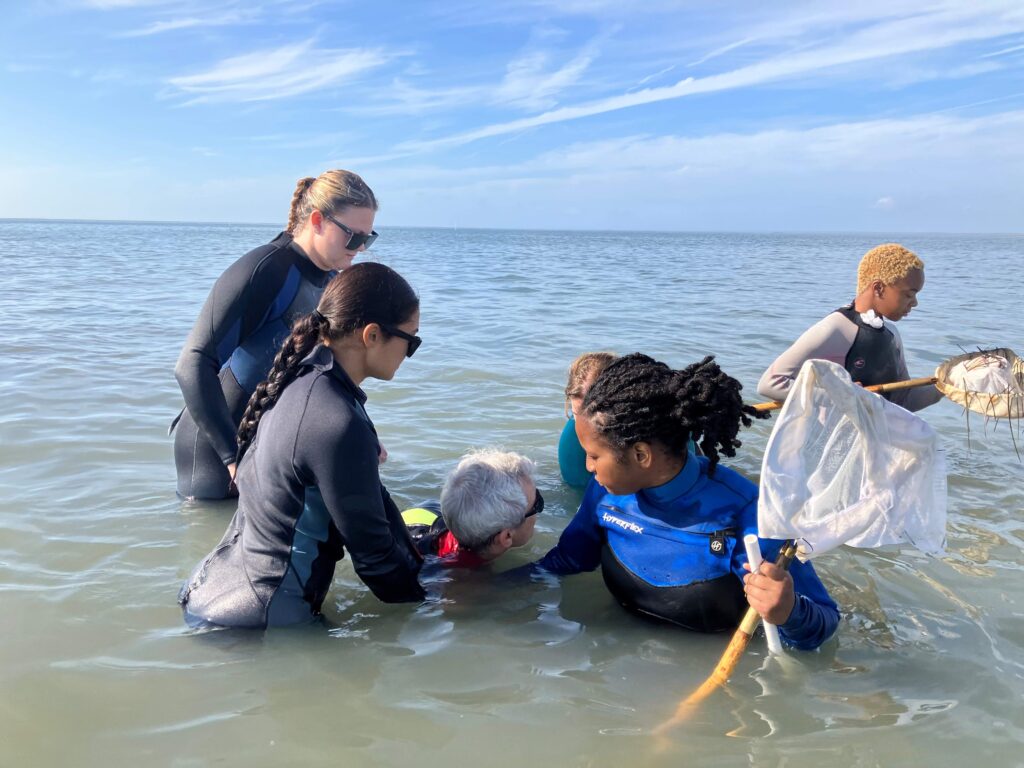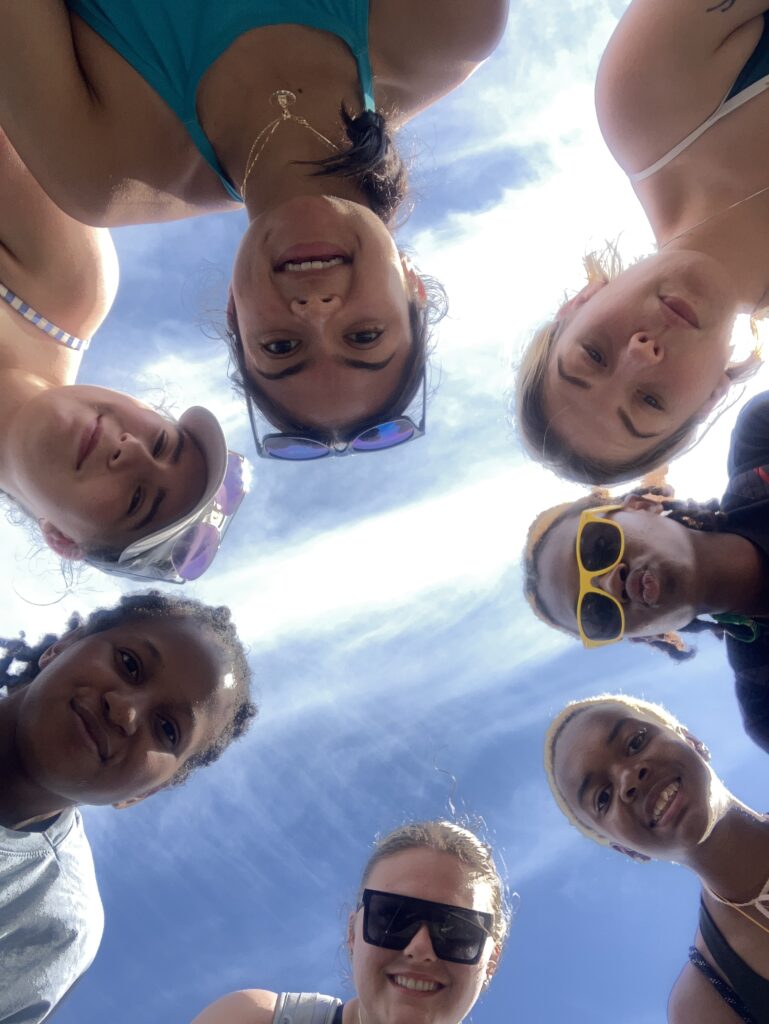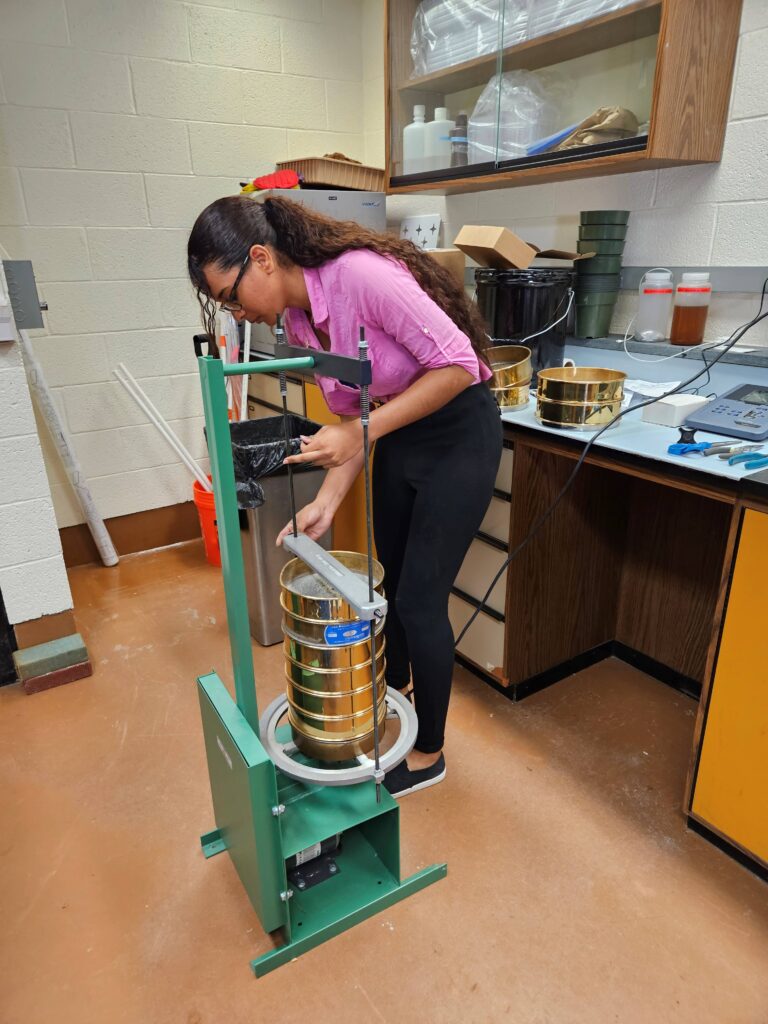Experiences for Undergraduates -
Applications are open!

Spend your summer doing real science as part of a collaboration among world-class researchers studying the last coastal wilderness on the East Coast.
National Science Foundation Research Experience for Undergraduates (REU) positions are available with the Virginia Coast Reserve Long-Term Ecological Research (VCR-LTER) program for summer 2023. VCR-LTER researchers study patterns and mechanisms of ecosystem function, connectivity, and state changes in the coastal barrier system – from mainland marshes to intertidal and subtidal bay habitats and barrier islands. Along with focusing on one of the specific projects listed below, REUs also help collect data for ongoing long-term field projects.
REUs spend the summer in a thriving research community; the VCR-LTER is based at UVA’s coastal field station in the small town of Oyster on Virginia’s Eastern Shore – one of the last coastal wildernesses on the east coast. The 10-week program begins the first full week of June. REUs are provided a stipend ($5,500) plus on-site lodging and research support administered through the University of Virginia. More information about VCR-LTER research initiatives and potential advisers can be found in Research Highlights at www.vcrlter.virginia.edu. Applicants seeking more information about specific projects may contact potential mentors directly. Program and application questions can be directed to Dr. Cora Baird, the program coordinator, at coraj@virginia.edu. Applications are due February 11th (Sunday) and offers will be extended beginning March 5th.
Please read through the project opportunities below. All projects are based at UVA’s Coastal Research Center on the Eastern Shore of Virginia unless otherwise noted.
To apply, complete the application available here: https://virginia.az1.qualtrics.com/jfe/form/SV_7O6lxBp7eaAGVYW
- Application elements you should be prepared to provide:
- Information about you, your education, your grad school interests or preparation
- Describe your existing research experience
- Briefly describe your interest in each of up to 2 projects, including information about relevant coursework or experience that has prepared you for this research, and how participation would advance your academic and career goals. (500 words max per project)
- Upload a resume or CV (include your last name in the file name)
- Contact information for one reference
- (Optional) upload transcripts; unofficial are fine
- Describe how you have handled failure, responded to pressures, or learned from mistakes. (500 words max)
- Share anything else we should know when considering your application
- *Participants must be US citizens.*
If you belong to an institution that is a member of the VA-NC Alliance for Minority Participation, you may also apply through the Alliance here: https://lsamp.virginia.edu/current-opportunities .

Projects available for summer 2024
Shorebird population response in a rapidly changing ecosystem - Dr. Sarah Karpanty (Virginia Tech)
The Virginia barrier island system along the coast of the Delmarva Peninsula provides an ideal setting for studying the response of coastal systems to climate-driven large-scale events, such as storms, and long-term trends, such as sea-level rise. The system is highly dynamic—it experiences high rates of sea-level rise and shoreline erosion that affect the elevation and structure of the dunes on the islands. These physical changes to the environment ultimately affect the vegetation and animal communities on the island, including shorebirds and their predators. This coastal system is a regional hotspot for breeding piping plovers, the northern extent of breeding Wilson’s Plovers, and supports the largest breeding population of American oystercatchers on the Atlantic and Gulf coasts. The barrier islands are also a migratory staging hotspot for long-distance shorebirds each April-June. Studies of these species in the context of other long term monitoring conducted in the VCR LTER project provides the unique opportunity to investigate how shorebird demography may signal ecosystem change and inform resilient coastal management. Our project aims to quantify how shorebird populations respond to this rapid, climate-driven ecosystem change by relating shorebird habitat use to changing island geomorphology, prey resources and vegetation structure. The 2024 REU will focus their efforts on understanding the diet and habitat selection of both long distance migrants (red knots and black-bellied plovers) and piping plovers in response to changing island geomorphology and warming ocean temperatures which affect prey.
Good to know: This project does involve some very long field days and irregular work hours depending on the animals’ behaviors (early mornings, work on weekends). You must be willing and capable of working outside daily under sometimes rigorous conditions (heat, humidity, biting insects) and walking up to 10 miles per day over sand while carrying research equipment (~ 20 lbs. maximum). Details will be discussed with the field team before the start of the season. **Students interested in the project may have the opportunity to begin research in mid-May. If interested, please indicate your availability for an early start in your application.**
Barrier island plant ecology & shrub expansion – Drs. Julie Zinnert (VCU) and Natasha Woods (Moravian University)
Grassland to shrubland transitions influence sediment delivery to the island interior and back-barrier marsh, affecting island migration patterns. Over several decades, shrub expansion has occurred into grassland across the landscape resulting in lower rates island migration rates. Temperature, dune elevation are known to influence the success of shrub establishment and growth. Shrubs occur in a narrow elevation range thought to be controlled by distance to the water table, yet not all locations that meet these thresholds are inhabited by shrubs and remain grasslands. The REU student will join a team of graduate students and their mentors to test the hypothesis that fresh groundwater controls shrub establishment. This student will assist in barrier island field measurements and laboratory analysis of above and belowground vegetation composition, and environmental characterization (e.g. groundwater measurements, soil salinity, water content, organic matter). Results from this project will be used to enhance models of barrier island to sea-level rise by better quantifying the controls on shrub establishment and expansion.
Good to know: We are a collaborative team and students will always work with others in the field. Field work may involve 6-8 hour days with breaks on a barrier island. Site access requires a 1.5 mile walk along the beach.
Inter-generational effects of salinization on trees and shrubs – Dr. Keryn Gedan (GWU)
The REU will be working at the Brownsville Preserve, where a forest is dying in response to sea level rise. An ecosystem-scale, long-term, multi-disciplinary experiment is being conducted on-site. The student will collect long-term datasets on trees, shrubs, and herbaceous vegetation to contribute to our understanding of ghost forest formation and marsh migration in response to sea level rise. There will also be an opportunity for independent research to investigate the inter-generational effects of salinization on plant offspring. For example, we might collect seeds from trees (of the same species) growing at opposite ends of the sea level rise gradient and grow them in common conditions to investigate how they tolerate salinity and flooding stresses. We will work together to design this study.
Good to know: Much of your time will be spent in the field. My students and I visit on short trips throughout the summer to work side-by-side and teach methods. Other work is done independently or in partnership with other REUs. You will learn to identify plants, describe plant cover, and use forestry methodologies. Study sites are accessed by hiking through coastal forest, where conditions can be hot and buggy.
Ecophysiology of salt-affected trees – Dr. Keryn Gedan (GWU)
Have you wondered how plants move water, or how trees are affected by drought and osmotic stress? This project will explore the ecophysiological mechanisms of plant tolerance to salinity stress. We have observed that over the course of the summer, water potentials of tree stems at the forest edge becomes more negative than it does in the forest interior, an indication of osmotic stress and hydraulic vulnerability. In this project, you will collect tree branches from the forest to work with in the laboratory to create hydraulic vulnerability curves in an experimental context. We expect to see plasticity within species in their hydraulic vulnerability that corresponds to the conditions from which they were collected. The REU will be working at the Brownsville Preserve, where a forest is dying in response to sea level rise. The REU will also be expected contribute to a forest tree census and annual vegetation surveys.
Good to know: Much of your time will be spent in the field. My students and I visit on short trips throughout the summer to work side-by-side and teach methods. Other work is done independently or in partnership with other REUs. You will learn to identify plants, describe plant cover, and use forestry methodologies. Study sites are accessed by hiking through coastal forest, where conditions can be hot and buggy.

